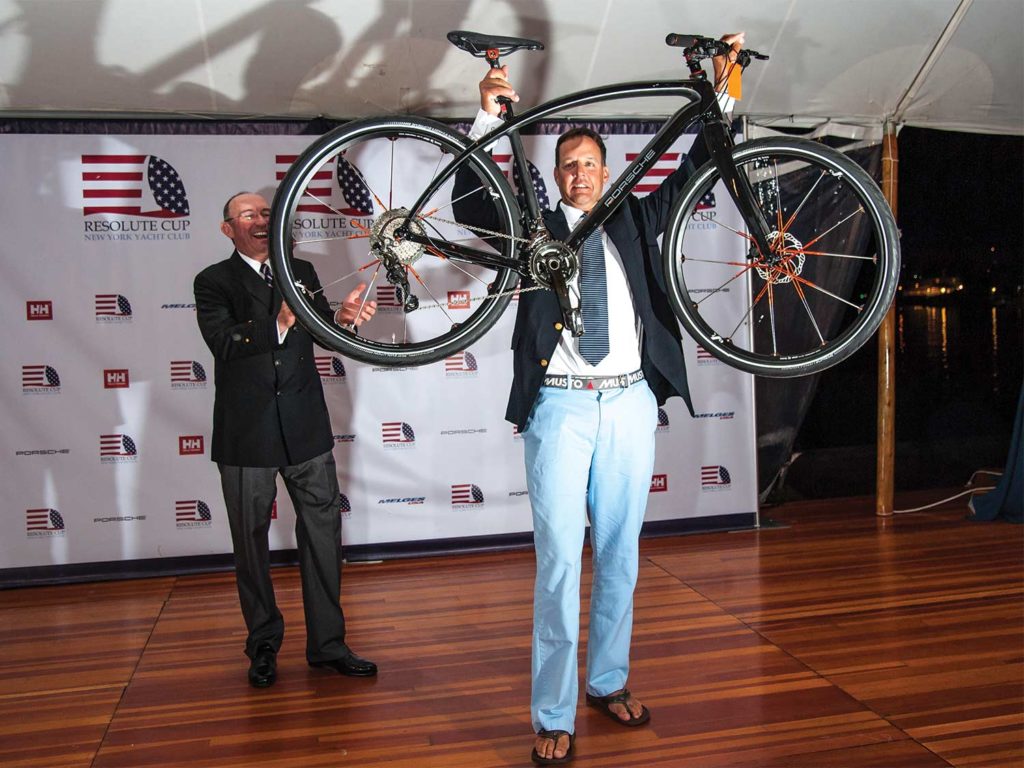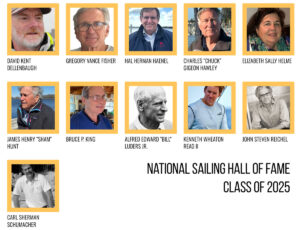
The moment you hear your name called to receive an award is one of satisfaction, excitement and a sort of validation of the effort invested to earn it. The announcement is followed by applause from your competitors as you are handed a keepsake reminder of your success. It’s a euphoric moment, but then, a few days later, you have a quandary. What do I do with the darn thing?
Over the past winter, I decided to take stock of the inventory of awards and trophies I have received over the years. Many were stuffed in boxes and buried in the basement or the garage. Clearly, the euphoria of the moment faded over time. The exercise made me think about trophies and their value, and helped me recall great moments on the racecourse. The extraordinary thing I realized was that for every trophy I had received, there were far more regattas where I did not. Such trophies are reminders of good times, but they are certainly not the most important takeaway from racing a sailboat.
My personal collection includes an eclectic mix of objects: cups, bowls, plates, crystal, ice buckets, binoculars, barometers, flags, certificates, plaques, boxes, a chair, jackets, foul-weather gear, books, framed pictures, decanters, a working canon, knives, silverware, bottles of wine, trophies of every shape, an oil lantern, compasses, strange plastic trophies, artwork, and a couple of Rolex timepieces. And yes, there’s even a peace pipe. Awards that seemed insignificant to me ended up back in boxes or sent off to a thrift shop. I just did not need 10 old jackets that I was unlikely to ever wear again. As I went through the collection, I decided to cull it, selecting an award with the most significance for each year of my sailing career.
My next step was to create an appropriate way to display the awards, and what I learned from the experience might be helpful for any yacht club or sailor when the time comes to tackle the trophy haul. Important trophies should be on display where everyone can see them. The trophy can be preserved in a glass case, or out in the open to be handled, shared and admired. If it’s genuinely valuable, say an Olympic medal or an ornate piece that’s irreplaceable, there should be an element of security and protection. Trophies should be spaced apart so they don’t get muddled on a shelf. Good lighting helps viewers to see the engraving. I suggest posting a list of the winners on a wall next to the case because too many trophies end up with the winners listed on the back, and their names get lost.
My favorite trophies include a Windsor chair presented by the United States Merchant Marine Academy to our crew on Courageous for winning the America’s Cup. The chair has a nifty worded plaque on the back and is a comfortable place to sit. It is 44 years old and still looks good. The America’s Cup Hall of Fame presented me with a cool half-model of Reliance, and one of my all-time favorites is a small blue flag with a white rooster on it. I won it in the last race of the season on Barnegat Bay in 1973. In the bottom of one of the boxes, I found an engraved trophy with the name of my great aunt, Frances Wemple. She finished third for the season in 1927 at the now-defunct Polyhue YC. The burgee on the trophy has six colors, hence poly hue (many colors). I decided the small cup should remain on my shelf because I never knew Aunt Frances; she died at a young age in the 1930s.
The most famous trophy in sailing is the America’s Cup, of course. Huge fortunes have been spent on the quest to win it. The Cup itself is kind of a gaudy pear-shaped object. It looks like a pitcher but is actually bottomless. It was one of eight identical trophies manufactured by R & S Garrard in London in 1851. The original Cup was 27 inches high and weighed 134 ounces of silver. Additional extensions to its base have been added over the years. Originally, the Cup was called the 100 Guineas Cup because that was its cost. The name of the trophy was changed in honor of the schooner, America, that won it for defeating 15 British yachts in a race around the Isle of Wight.
The iconic trophy was called ordinary when it was first presented, but today it is revered as the most prestigious prize in sailing. In October 1995, a deranged New Zealand activist took a sledge hammer to the Cup and smashed it. The perpetrator received a stiff prison sentence, and the Royal New Zealand Yacht Squadron shipped the mangled piece of silver back to Garrard in London for a complete rebuild. White-gloved security for the Cup has been tighter ever since.
Throughout his many years challenging for the America’s Cup, Sir Thomas Lipton traveled around the United States presenting Lipton Cups to different yacht clubs. One of those went to the Grand Lake YC in the Rocky Mountains of Colorado. Lipton had been invited to visit by a lawyer during cocktails one evening at the New York YC. Several months later, Lipton stopped in Denver for two days while traveling via train from San Francisco to New York City. At an elaborate dinner that was described as “the social event of the year,” Lipton committed to giving the yacht club a Challenge Cup. A few months later, one of Lipton’s trophies arrived at the club, and a regatta has been an important event ever since.
In November 1919, Lipton visited the Southern YC in New Orleans and promised a trophy for the “advancement of sailing in inter-club competition in Fish Class sloops.” The club’s minutes announced the big moment: “Thomas J. Lipton’s gift arrived from England, a magnificent silver trophy handcrafted by silversmiths in England, whereupon a resolution was adopted and Sir Thomas was sent an honorary membership.” Of course, Lipton was using his gifts to promote Lipton tea, but it didn’t matter to the recipients. Lipton was a popular figure thanks to his persistent pursuit of the America’s Cup.
Sometimes the actual trophy is a little different than advertised. For example, the Kaiser of Germany once presented a gold cup called the Kaiser’s Cup for the Transatlantic Race in 1905. Years later, it was discovered that the trophy was actually cheap metal covered with gold plating. Authenticity counts, and the Kaiser fell short with his ploy.
The New York YC has a vast collection of important trophies, and in 2019, the club published a booklet about its collection, authored by curator Alice W. Dickson. “Presentation pieces are compelling because they were often the most ambitious work that a firm would do,” Dickson writes. “These special commissions were opportunities for manufacturers or designers to show off and promote their skills.”
Some of the most interesting trophies in sailing include the Lighthouse Trophy for winning the Newport to Bermuda Race, the Barn Door for the Transpacific Ocean Race, the Toms River YC Challenge Cup that dates back to 1871, the Bilge Puller, presented to the winner of the E Scow National Championship since 1961, the Congressional Cup, deeded to the Long Beach YC by an act of Congress, and the Governor’s Cup youth match race regatta, which received its deed from California’s then-Gov. Ronald Reagan.
There are times when trophies are retired. One example is the Adams Cup for the North American Women’s Sailing Championship dating back to 1924, which was retired in 2011. The America’s Cup Challengers raced for the Louis Vuitton Trophy from 1983 through 2017. The regatta was sponsored by fashion house Prada in 2021, and the company presented the Prada Cup to the winner of the challenger trials instead.
Trophies are important reminders of victories and the memories that come with them, and you will appreciate them by displaying trophies that are meaningful, but I suggest not letting volume overwhelm your collection. After one deeper purge, I took away some trophies from years that were not particularly compelling, which made the remaining awards a little more outstanding.
In the summer of 2019, a boat I had been racing on received an award for being the top overall competitor during the previous two years. I sat in the back of the auditorium as our owners got up on stage to accept the trophy. There was no memento for the rest of the crew, but I didn’t mind. I felt great satisfaction for just being a participant, which reminded me that memories of our victories are reward enough.
It doesn’t take much to be acknowledged. Sometimes a simple piece of cloth is all it takes, which is why my rooster flag will always be special and has a permanent place among the more illustrious hardware.









